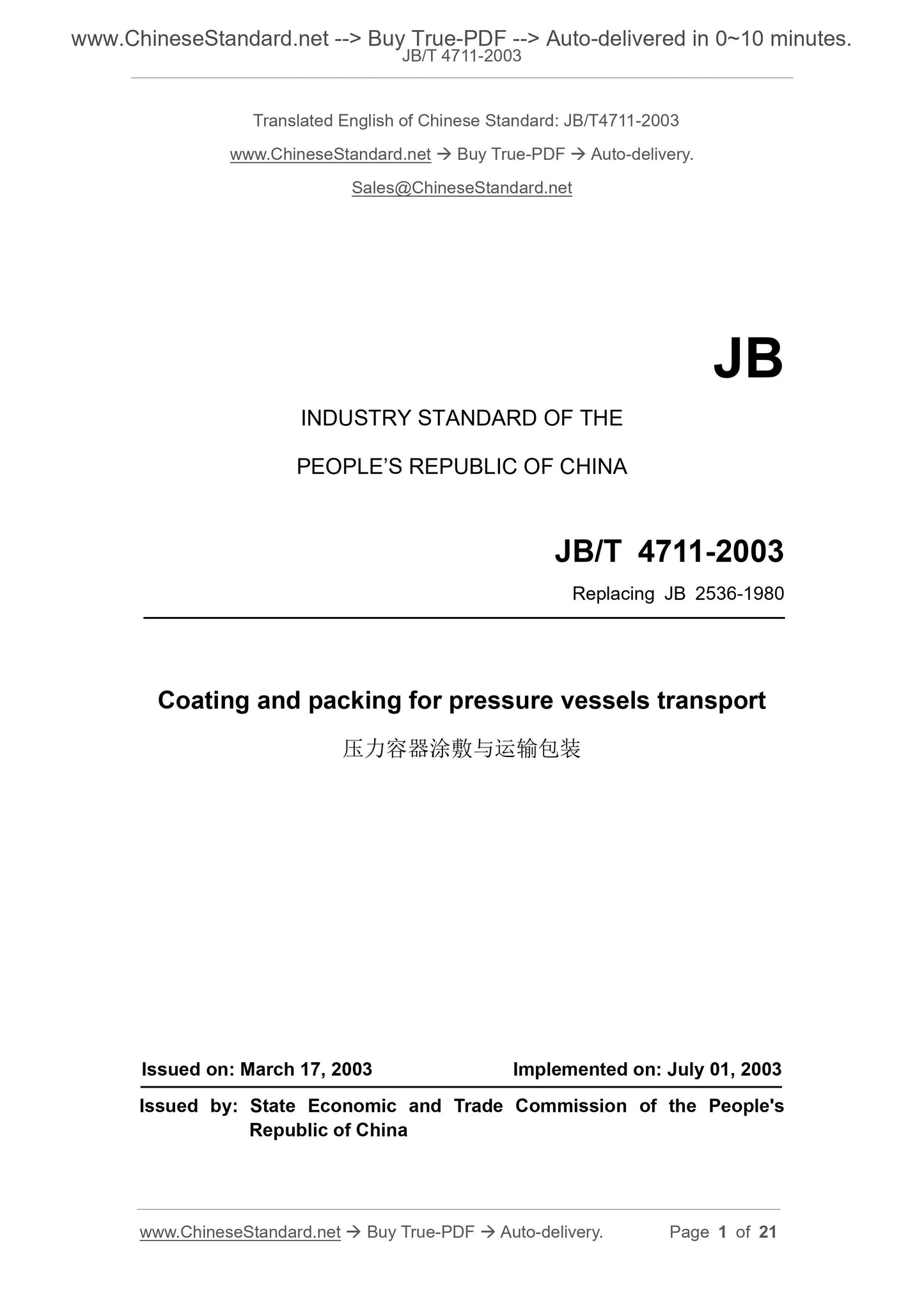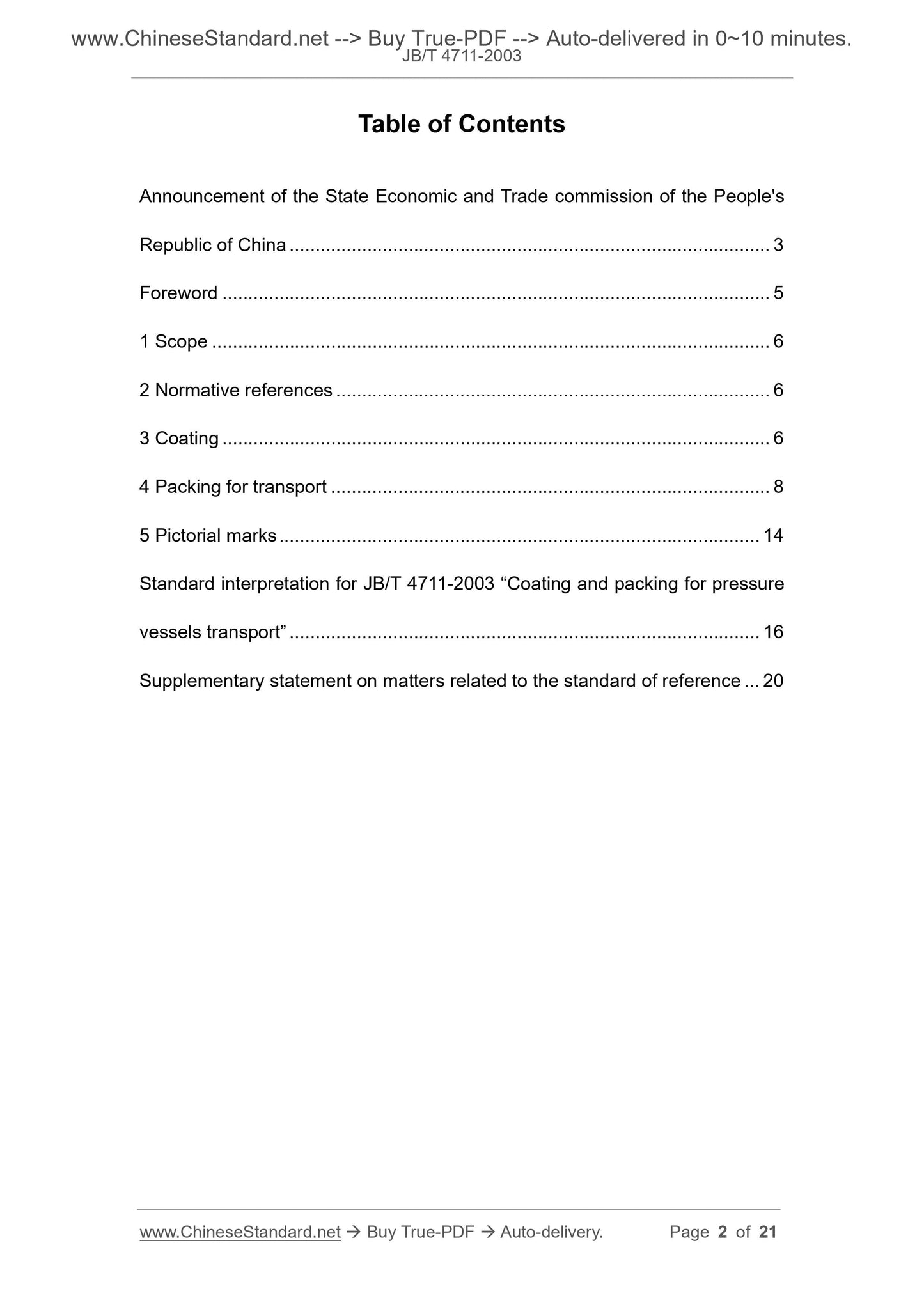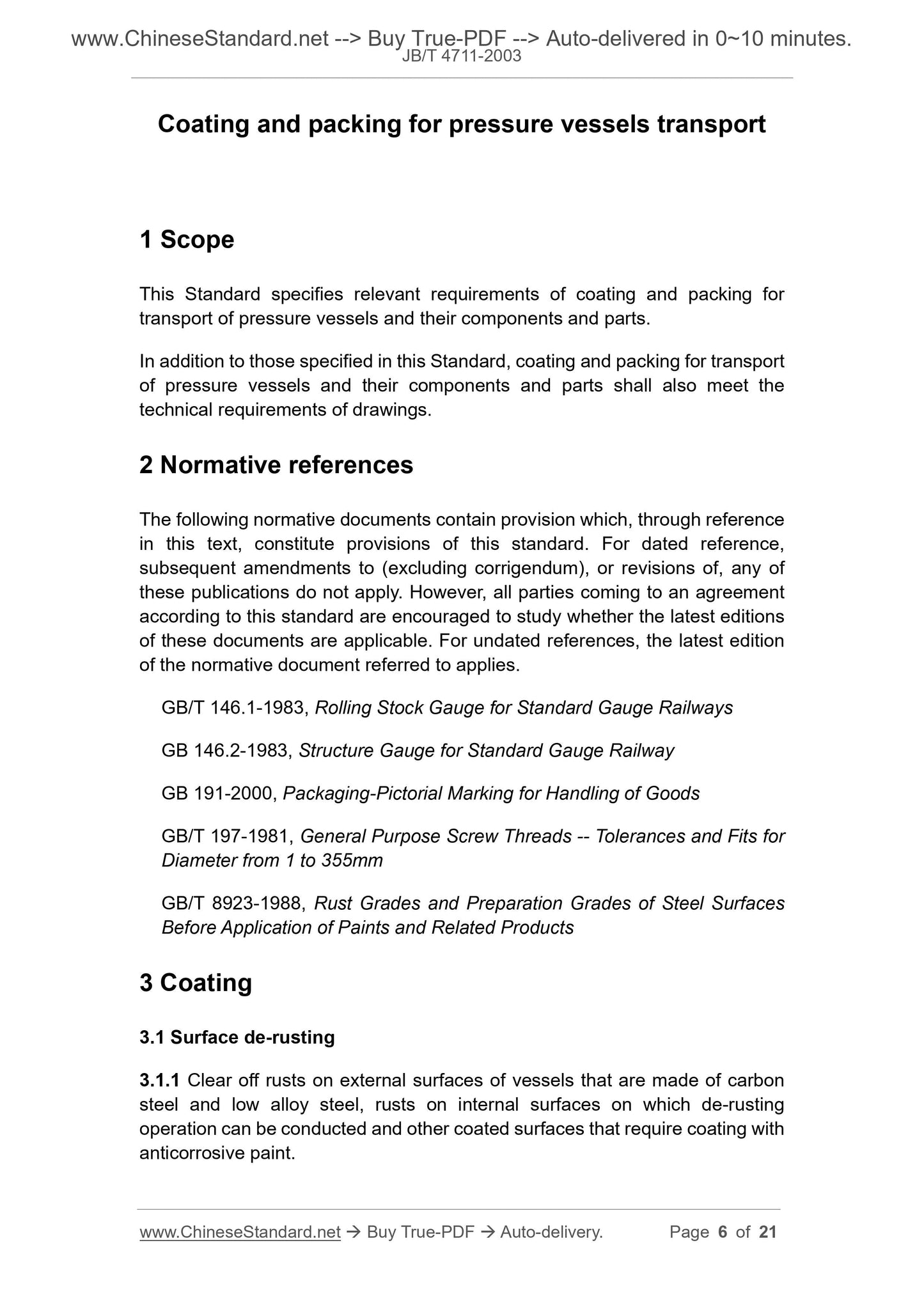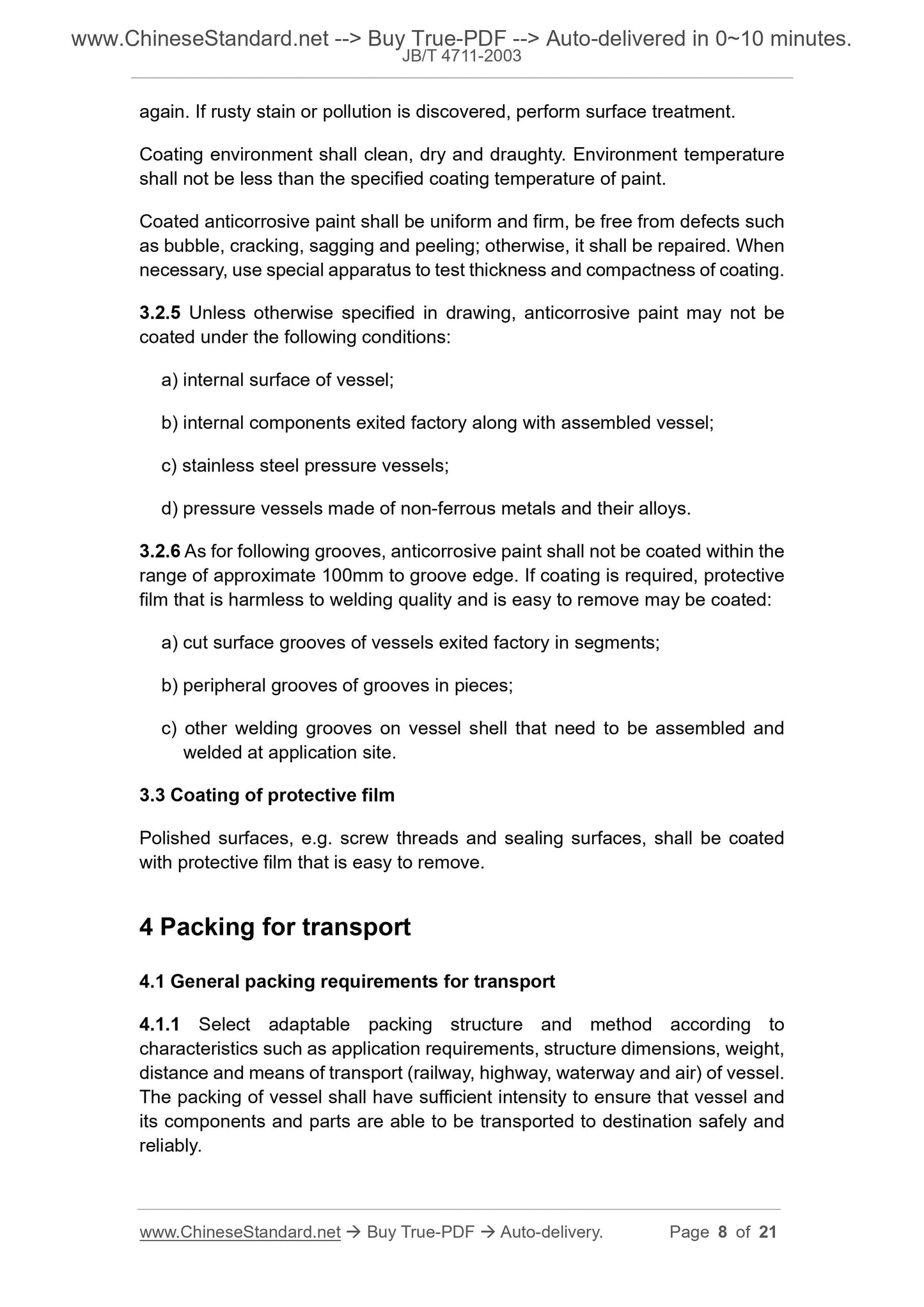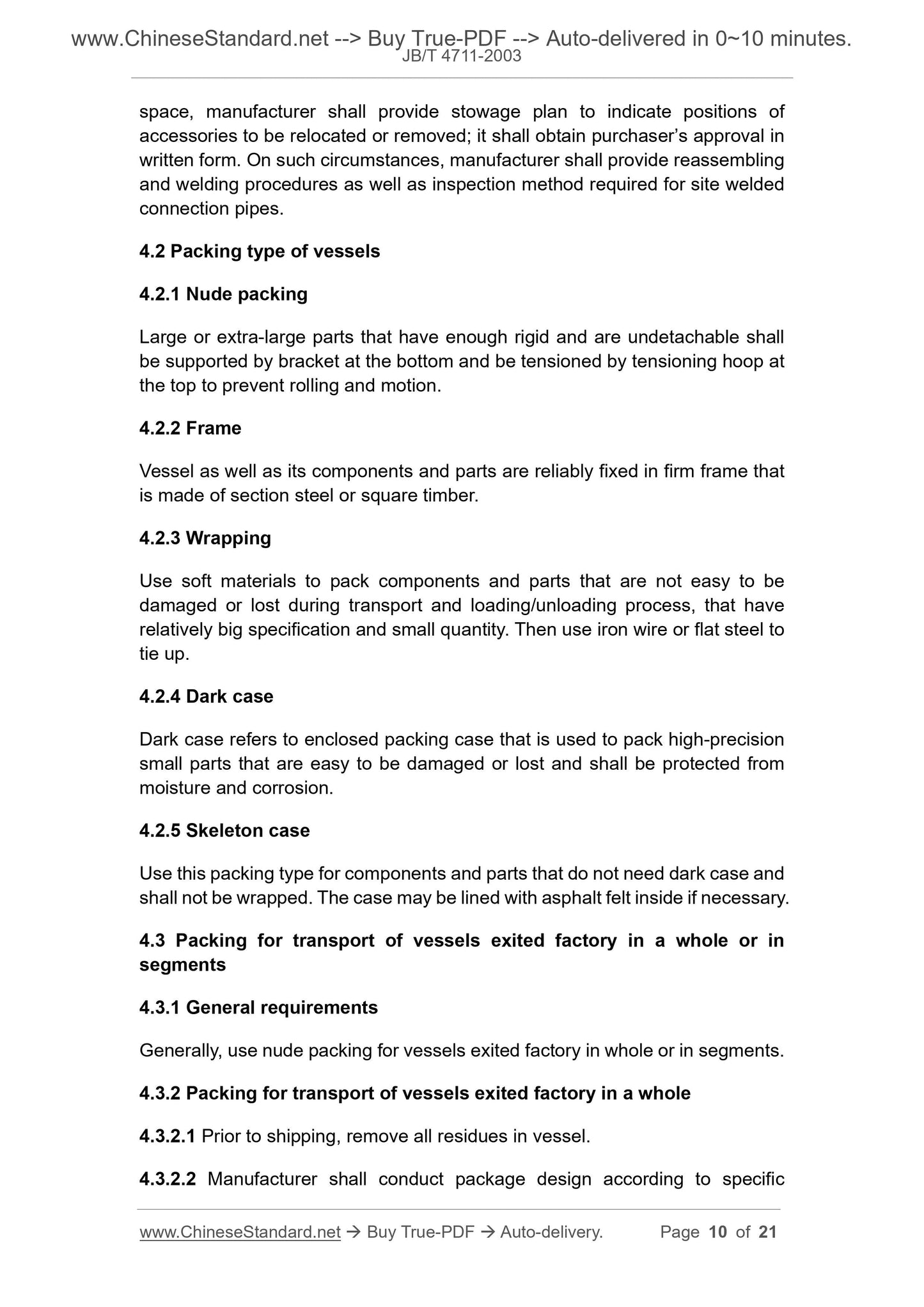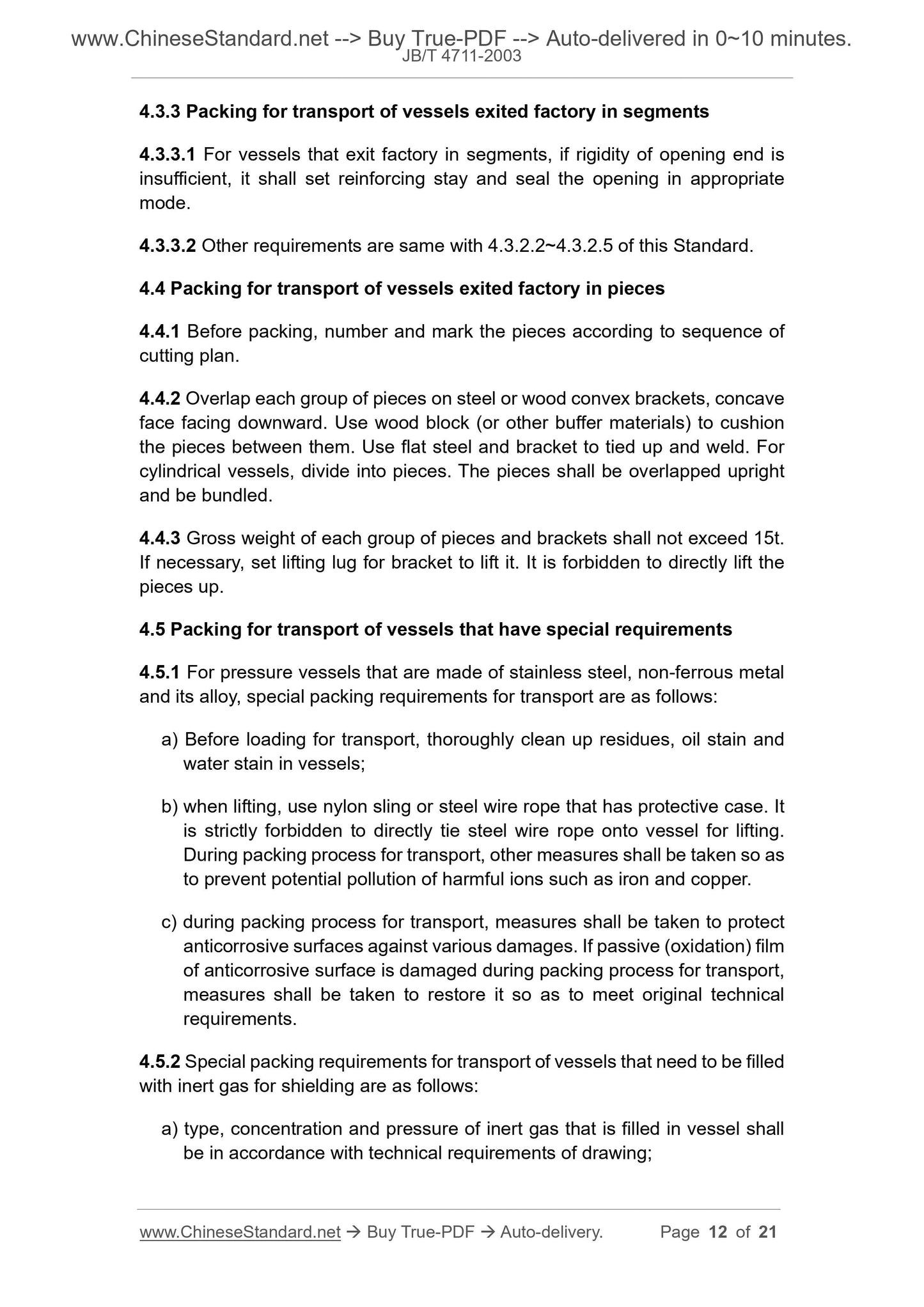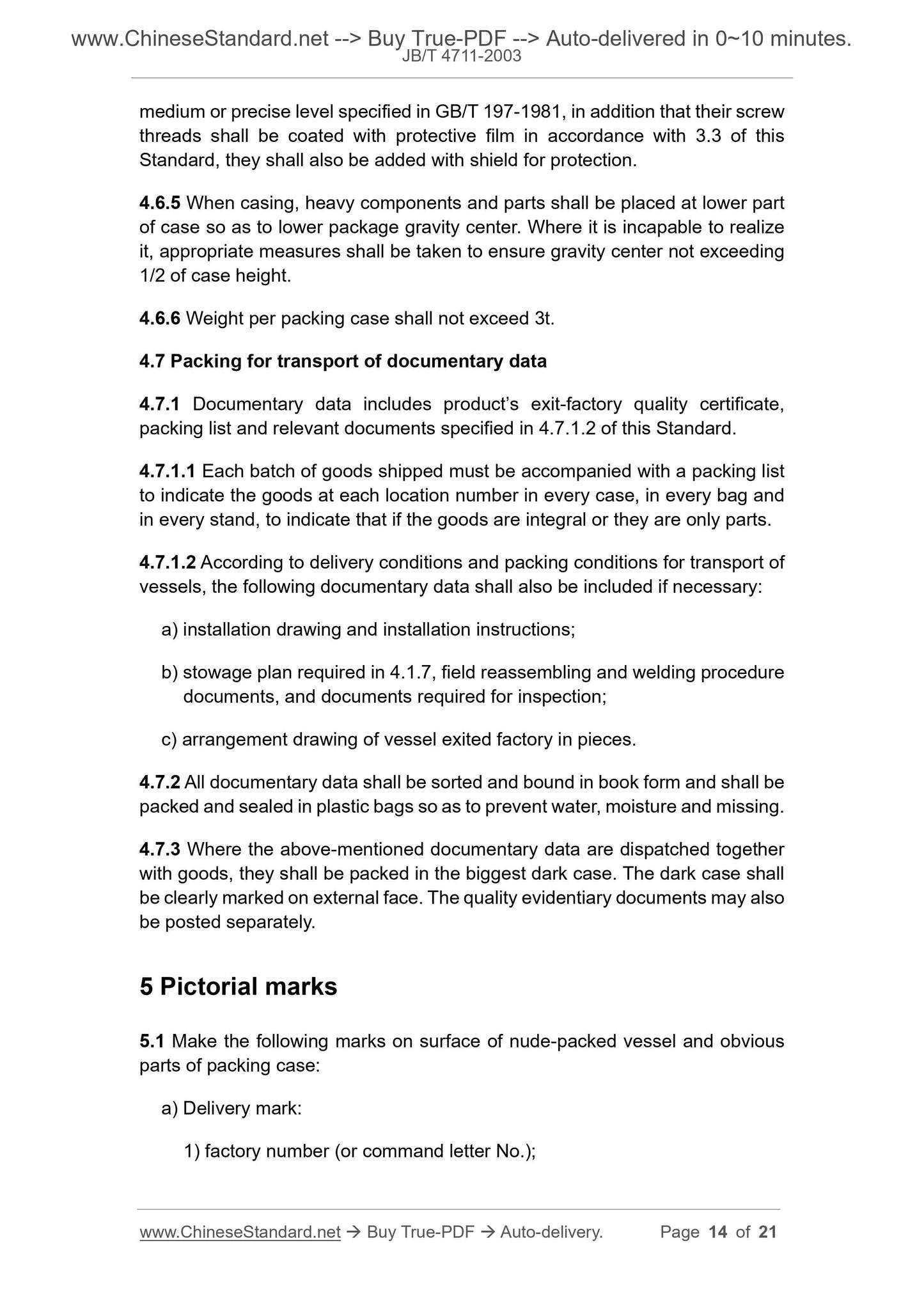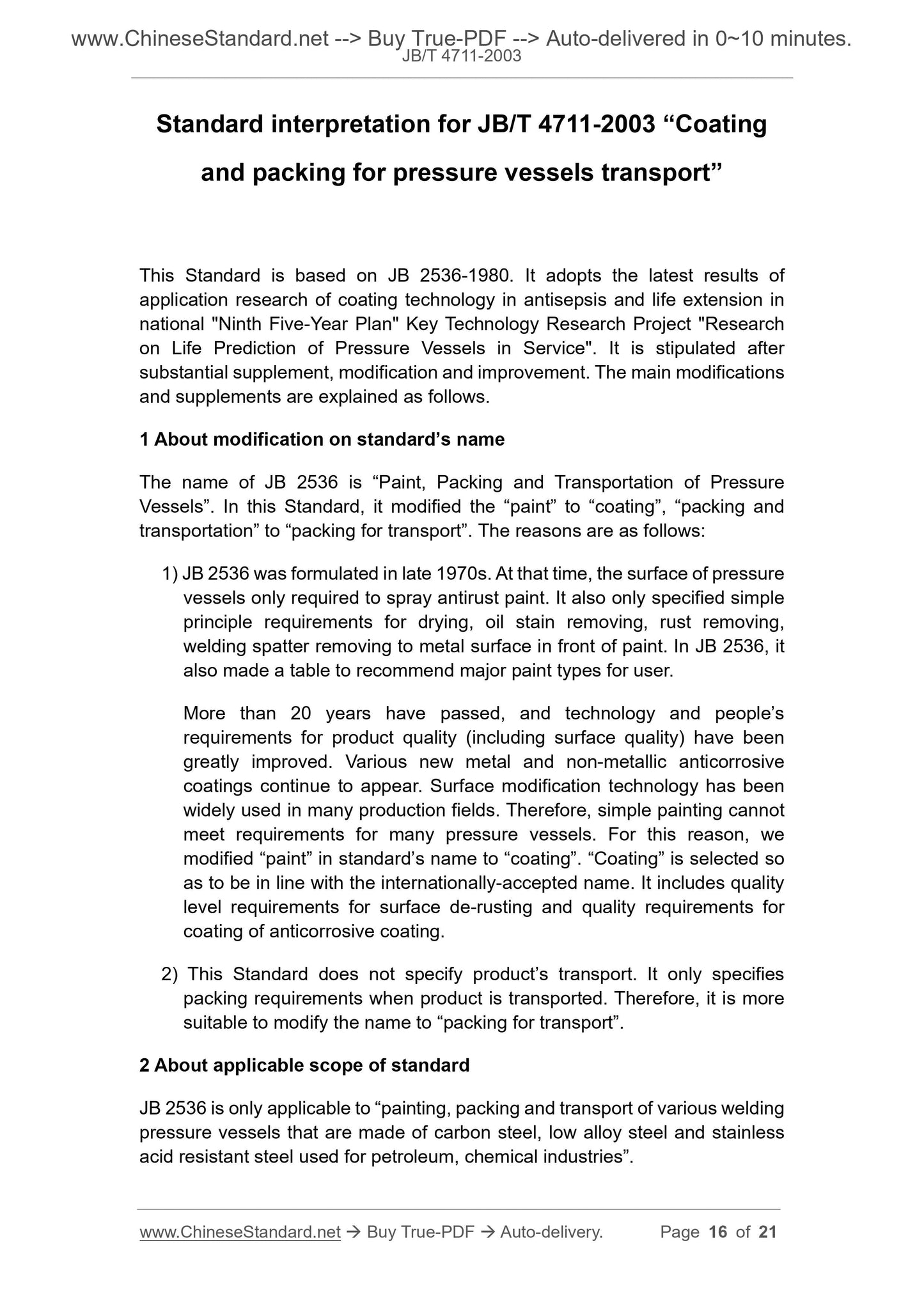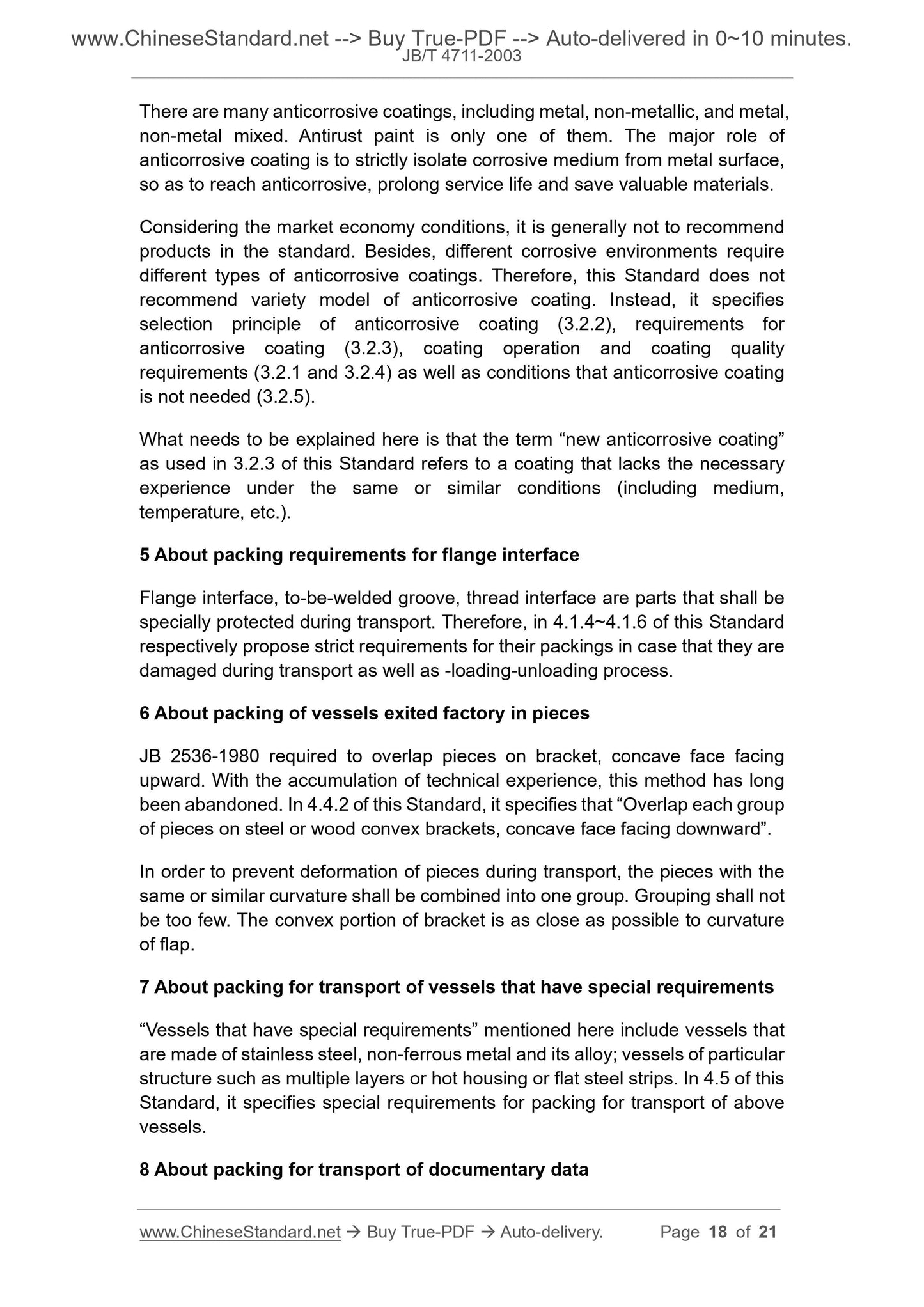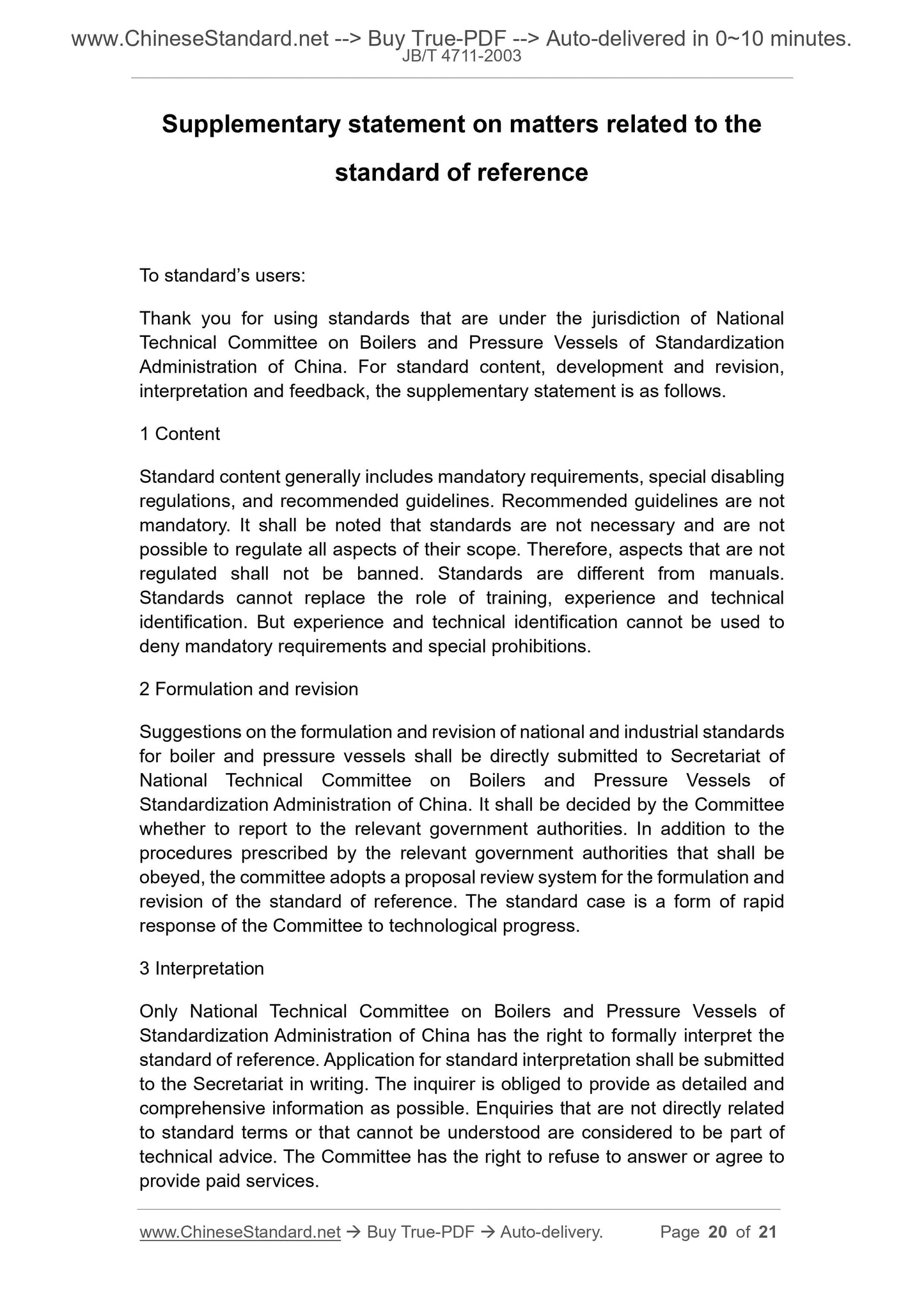1
/
of
10
PayPal, credit cards. Download editable-PDF and invoice in 1 second!
JB/T 4711-2003 English PDF (JBT4711-2003)
JB/T 4711-2003 English PDF (JBT4711-2003)
Regular price
$85.00 USD
Regular price
Sale price
$85.00 USD
Unit price
/
per
Shipping calculated at checkout.
Couldn't load pickup availability
Delivery: 3 seconds. Download true-PDF + Invoice.
Get QUOTATION in 1-minute: Click JB/T 4711-2003
Historical versions: JB/T 4711-2003
Preview True-PDF (Reload/Scroll if blank)
JB/T 4711-2003: Coating and packing for pressure vessels transport
JB/T 4711-2003
INDUSTRY STANDARD OF THE
PEOPLE’S REPUBLIC OF CHINA
Replacing JB 2536-1980
Coating and packing for pressure vessels transport
压力容器涂敷与运输包装
ISSUED ON: MARCH 17, 2003
IMPLEMENTED ON: JULY 01, 2003
Issued by: State Economic and Trade Commission of the People's
Republic of China
Table of Contents
Announcement of the State Economic and Trade commission of the People's
Republic of China ... 3
Foreword ... 5
1 Scope ... 6
2 Normative references ... 6
3 Coating ... 6
4 Packing for transport ... 8
5 Pictorial marks ... 14
Standard interpretation for JB/T 4711-2003 “Coating and packing for pressure
vessels transport” ... 16
Supplementary statement on matters related to the standard of reference ... 20
Coating and packing for pressure vessels transport
1 Scope
This Standard specifies relevant requirements of coating and packing for
transport of pressure vessels and their components and parts.
In addition to those specified in this Standard, coating and packing for transport
of pressure vessels and their components and parts shall also meet the
technical requirements of drawings.
2 Normative references
The following normative documents contain provision which, through reference
in this text, constitute provisions of this standard. For dated reference,
subsequent amendments to (excluding corrigendum), or revisions of, any of
these publications do not apply. However, all parties coming to an agreement
according to this standard are encouraged to study whether the latest editions
of these documents are applicable. For undated references, the latest edition
of the normative document referred to applies.
GB/T 146.1-1983, Rolling Stock Gauge for Standard Gauge Railways
GB 146.2-1983, Structure Gauge for Standard Gauge Railway
GB 191-2000, Packaging-Pictorial Marking for Handling of Goods
GB/T 197-1981, General Purpose Screw Threads -- Tolerances and Fits for
Diameter from 1 to 355mm
GB/T 8923-1988, Rust Grades and Preparation Grades of Steel Surfaces
Before Application of Paints and Related Products
3 Coating
3.1 Surface de-rusting
3.1.1 Clear off rusts on external surfaces of vessels that are made of carbon
steel and low alloy steel, rusts on internal surfaces on which de-rusting
operation can be conducted and other coated surfaces that require coating with
anticorrosive paint.
again. If rusty stain or pollution is discovered, perform surface treatment.
Coating environment shall clean, dry and draughty. Environment temperature
shall not be less than the specified coating temperature of paint.
Coated anticorrosive paint shall be uniform and firm, be free from defects such
as bubble, cracking, sagging and peeling; otherwise, it shall be repaired. When
necessary, use special apparatus to test thickness and compactness of coating.
3.2.5 Unless otherwise specified in drawing, anticorrosive paint may not be
coated under the following conditions:
a) internal surface of vessel;
b) internal components exited factory along with assembled vessel;
c) stainless steel pressure vessels;
d) pressure vessels made of non-ferrous metals and their alloys.
3.2.6 As for following grooves, anticorrosive paint shall not be coated within the
range of approximate 100mm to groove edge. If coating is required, protective
film that is harmless to welding quality and is easy to remove may be coated:
a) cut surface grooves of vessels exited factory in segments;
b) peripheral grooves of grooves in pieces;
c) other welding grooves on vessel shell that need to be assembled and
welded at application site.
3.3 Coating of protective film
Polished surfaces, e.g. screw threads and sealing surfaces, shall be coated
with protective film that is easy to remove.
4 Packing for transport
4.1 General packing requirements for transport
4.1.1 Select adaptable packing structure and method according to
characteristics such as application requirements, structure dimensions, weight,
distance and means of transport (railway, highway, waterway and air) of vessel.
The packing of vessel shall have sufficient intensity to ensure that vessel and
its components and parts are able to be transported to destination safely and
reliably.
space, manufacturer shall provide stowage plan to indicate positions of
accessories to be relocated or removed; it shall obtain purchaser’s approval in
written form. On such circumstances, manufacturer shall provide reassembling
and welding procedures as well as inspection method required for site welded
connection pipes.
4.2 Packing type of vessels
4.2.1 Nude packing
Large or extra-large parts that have enough rigid and are undetachable shall
be supported by bracket at the bottom and be tensioned by tensioning hoop at
the top to prevent rolling and motion.
4.2.2 Frame
Vessel as well as its components and parts are reliably fixed in firm frame that
is made of section steel or square timber.
4.2.3 Wrapping
Use soft materials to pack components and parts that are not easy to be
damaged or lost during transport and loading/unloading process, that have
relatively big specification and small quantity. Then use iron wire or flat steel to
tie up.
4.2.4 Dark case
Dark case refers to enclosed packing case that is used to pack high-precision
small parts that are easy to be damaged or lost and shall be protected from
moisture and corrosion.
4.2.5 Skeleton case
Use this packing type for components and parts that do not need dark case and
shall not be wrapped. The case may be lined with asphalt felt inside if necessary.
4.3 Packing for transport of vessels exited factory in a whole or in
segments
4.3.1 General requirements
Generally, use nude packing for vessels exited factory in whole or in segments.
4.3.2 Packing for transport of vessels exited factory in a whole
4.3.2.1 Prior to shipping, remove all residues in vessel.
4.3.2.2 Manufacturer shall conduct package design according to specific
4.3.3 Packing for transport of vessels exited factory in segments
4.3.3.1 For vessels that exit factory in segments, if rigidity of opening end is
insufficient, it shall set reinforcing stay and seal the opening in appropriate
mode.
4.3.3.2 Other requirements are same with 4.3.2.2~4.3.2.5 of this Standard.
4.4 Packing for transport of vessels exited factory in pieces
4.4.1 Before packing, number and mark the pieces according to sequence of
cutting plan.
4.4.2 Overlap each group of pieces on steel or wood convex brackets, concave
face facing downward. Use wood block (or other buffer materials) to cushion
the pieces between them. Use flat steel and bracket to tied up and weld. For
cylindrical vessels, divide into pieces. The pieces shall be overlapped upright
and be bundled.
4.4.3 Gross weight of each group of pieces and brackets shall not exceed 15t.
If necessary, set lifting lug for bracket to lift it. It is forbidden to directly lift the
pieces up.
4.5 Packing for transport of vessels that have special requirements
4.5.1 For pressure vessels that are made of stainless steel, non-ferrous metal
and its alloy, special packing requirements for transport are as follows:
a) Before loading for transport, thoroughly clean up residues, oil stain and
water stain in vessels;
b) when lifting, use nylon sling or steel wire rope that has protective case. It
is strictly forbidden to directly tie steel wire rope onto vessel for lifting.
During packi...
Get QUOTATION in 1-minute: Click JB/T 4711-2003
Historical versions: JB/T 4711-2003
Preview True-PDF (Reload/Scroll if blank)
JB/T 4711-2003: Coating and packing for pressure vessels transport
JB/T 4711-2003
INDUSTRY STANDARD OF THE
PEOPLE’S REPUBLIC OF CHINA
Replacing JB 2536-1980
Coating and packing for pressure vessels transport
压力容器涂敷与运输包装
ISSUED ON: MARCH 17, 2003
IMPLEMENTED ON: JULY 01, 2003
Issued by: State Economic and Trade Commission of the People's
Republic of China
Table of Contents
Announcement of the State Economic and Trade commission of the People's
Republic of China ... 3
Foreword ... 5
1 Scope ... 6
2 Normative references ... 6
3 Coating ... 6
4 Packing for transport ... 8
5 Pictorial marks ... 14
Standard interpretation for JB/T 4711-2003 “Coating and packing for pressure
vessels transport” ... 16
Supplementary statement on matters related to the standard of reference ... 20
Coating and packing for pressure vessels transport
1 Scope
This Standard specifies relevant requirements of coating and packing for
transport of pressure vessels and their components and parts.
In addition to those specified in this Standard, coating and packing for transport
of pressure vessels and their components and parts shall also meet the
technical requirements of drawings.
2 Normative references
The following normative documents contain provision which, through reference
in this text, constitute provisions of this standard. For dated reference,
subsequent amendments to (excluding corrigendum), or revisions of, any of
these publications do not apply. However, all parties coming to an agreement
according to this standard are encouraged to study whether the latest editions
of these documents are applicable. For undated references, the latest edition
of the normative document referred to applies.
GB/T 146.1-1983, Rolling Stock Gauge for Standard Gauge Railways
GB 146.2-1983, Structure Gauge for Standard Gauge Railway
GB 191-2000, Packaging-Pictorial Marking for Handling of Goods
GB/T 197-1981, General Purpose Screw Threads -- Tolerances and Fits for
Diameter from 1 to 355mm
GB/T 8923-1988, Rust Grades and Preparation Grades of Steel Surfaces
Before Application of Paints and Related Products
3 Coating
3.1 Surface de-rusting
3.1.1 Clear off rusts on external surfaces of vessels that are made of carbon
steel and low alloy steel, rusts on internal surfaces on which de-rusting
operation can be conducted and other coated surfaces that require coating with
anticorrosive paint.
again. If rusty stain or pollution is discovered, perform surface treatment.
Coating environment shall clean, dry and draughty. Environment temperature
shall not be less than the specified coating temperature of paint.
Coated anticorrosive paint shall be uniform and firm, be free from defects such
as bubble, cracking, sagging and peeling; otherwise, it shall be repaired. When
necessary, use special apparatus to test thickness and compactness of coating.
3.2.5 Unless otherwise specified in drawing, anticorrosive paint may not be
coated under the following conditions:
a) internal surface of vessel;
b) internal components exited factory along with assembled vessel;
c) stainless steel pressure vessels;
d) pressure vessels made of non-ferrous metals and their alloys.
3.2.6 As for following grooves, anticorrosive paint shall not be coated within the
range of approximate 100mm to groove edge. If coating is required, protective
film that is harmless to welding quality and is easy to remove may be coated:
a) cut surface grooves of vessels exited factory in segments;
b) peripheral grooves of grooves in pieces;
c) other welding grooves on vessel shell that need to be assembled and
welded at application site.
3.3 Coating of protective film
Polished surfaces, e.g. screw threads and sealing surfaces, shall be coated
with protective film that is easy to remove.
4 Packing for transport
4.1 General packing requirements for transport
4.1.1 Select adaptable packing structure and method according to
characteristics such as application requirements, structure dimensions, weight,
distance and means of transport (railway, highway, waterway and air) of vessel.
The packing of vessel shall have sufficient intensity to ensure that vessel and
its components and parts are able to be transported to destination safely and
reliably.
space, manufacturer shall provide stowage plan to indicate positions of
accessories to be relocated or removed; it shall obtain purchaser’s approval in
written form. On such circumstances, manufacturer shall provide reassembling
and welding procedures as well as inspection method required for site welded
connection pipes.
4.2 Packing type of vessels
4.2.1 Nude packing
Large or extra-large parts that have enough rigid and are undetachable shall
be supported by bracket at the bottom and be tensioned by tensioning hoop at
the top to prevent rolling and motion.
4.2.2 Frame
Vessel as well as its components and parts are reliably fixed in firm frame that
is made of section steel or square timber.
4.2.3 Wrapping
Use soft materials to pack components and parts that are not easy to be
damaged or lost during transport and loading/unloading process, that have
relatively big specification and small quantity. Then use iron wire or flat steel to
tie up.
4.2.4 Dark case
Dark case refers to enclosed packing case that is used to pack high-precision
small parts that are easy to be damaged or lost and shall be protected from
moisture and corrosion.
4.2.5 Skeleton case
Use this packing type for components and parts that do not need dark case and
shall not be wrapped. The case may be lined with asphalt felt inside if necessary.
4.3 Packing for transport of vessels exited factory in a whole or in
segments
4.3.1 General requirements
Generally, use nude packing for vessels exited factory in whole or in segments.
4.3.2 Packing for transport of vessels exited factory in a whole
4.3.2.1 Prior to shipping, remove all residues in vessel.
4.3.2.2 Manufacturer shall conduct package design according to specific
4.3.3 Packing for transport of vessels exited factory in segments
4.3.3.1 For vessels that exit factory in segments, if rigidity of opening end is
insufficient, it shall set reinforcing stay and seal the opening in appropriate
mode.
4.3.3.2 Other requirements are same with 4.3.2.2~4.3.2.5 of this Standard.
4.4 Packing for transport of vessels exited factory in pieces
4.4.1 Before packing, number and mark the pieces according to sequence of
cutting plan.
4.4.2 Overlap each group of pieces on steel or wood convex brackets, concave
face facing downward. Use wood block (or other buffer materials) to cushion
the pieces between them. Use flat steel and bracket to tied up and weld. For
cylindrical vessels, divide into pieces. The pieces shall be overlapped upright
and be bundled.
4.4.3 Gross weight of each group of pieces and brackets shall not exceed 15t.
If necessary, set lifting lug for bracket to lift it. It is forbidden to directly lift the
pieces up.
4.5 Packing for transport of vessels that have special requirements
4.5.1 For pressure vessels that are made of stainless steel, non-ferrous metal
and its alloy, special packing requirements for transport are as follows:
a) Before loading for transport, thoroughly clean up residues, oil stain and
water stain in vessels;
b) when lifting, use nylon sling or steel wire rope that has protective case. It
is strictly forbidden to directly tie steel wire rope onto vessel for lifting.
During packi...
Share
